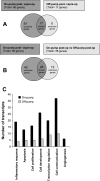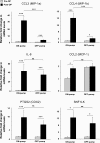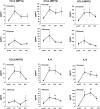Off-pump coronary artery bypass surgery is associated with fewer gene expression changes in the human myocardium in comparison with on-pump surgery
- PMID: 20332183
- PMCID: PMC2888559
- DOI: 10.1152/physiolgenomics.00174.2009
Off-pump coronary artery bypass surgery is associated with fewer gene expression changes in the human myocardium in comparison with on-pump surgery
Abstract
Off-pump coronary artery bypass surgery reduces the myocardial injury associated with on pump surgery with cardiopulmonary bypass (CPB) and ischemic-cardioplegic arrest (CA). We sought to find a mechanistic explanation for this by comparing the transcriptomic changes in the myocardium of patients undergoing on- and off-pump surgery. Transcriptomic analyses were performed on left ventricular biopsies obtained from patients prior to (pre-op) and after completion of all coronary anastomoses (post-op). Microarray results were validated with real-time polymerase chain reaction. In on-pump group, 68 genes were upregulated in post-op vs. pre-op biopsies (P < 0.01, >or=2-fold). They included inflammatory genes CCL3 and CCL4, apoptotic gene GADD45B and prostaglandin synthesis gene PTGS2 (COX-2). In the off-pump group, 17 genes were upregulated in post-op vs. pre-op biopsies (P < 0.01, >or=2-fold), all shared with on-pump patients. To uncover the genes implicated in CPB and ischemic-CA response, we compared the postoperative gene profiles of the two groups. Thirty-eight genes were upregulated in the on-pump vs. off-pump patients (P < 0.01, >or=2-fold). On-pump surgery induces injury-related response, as demonstrated by the upregulation of apoptosis and remodeling markers, whereas off-pump surgery ameliorates that by mainly upregulating a cytoprotective genetic program. Blood levels of the identified cytokines and chemokines followed the same pattern obtained by transcriptomics, suggesting that the myocardium is a likely source for these proteomic changes. In conclusion, off-pump surgery is associated with fewer alterations in gene expression connected with inflammation, apoptosis, and remodeling seen after on-pump surgery with CPB and ischemic-CA.
Figures




Similar articles
-
Higher levels of serum cytokines and myocardial tissue markers during on-pump versus off-pump coronary artery bypass surgery.J Card Surg. 2006 Jul-Aug;21(4):395-402. doi: 10.1111/j.1540-8191.2006.00272.x. J Card Surg. 2006. PMID: 16846420 Clinical Trial.
-
Pro-inflammatory cytokines after different kinds of cardio-thoracic surgical procedures: is what we see what we know?Eur J Cardiothorac Surg. 2005 Oct;28(4):569-75. doi: 10.1016/j.ejcts.2005.07.007. Eur J Cardiothorac Surg. 2005. PMID: 16135408
-
Comparison of m-RNA expression for inflammatory mediators in leukocytes between on-pump and off-pump coronary artery bypass grafting.Ann Thorac Cardiovasc Surg. 2003 Feb;9(1):43-9. Ann Thorac Cardiovasc Surg. 2003. PMID: 12667129
-
Meta-analysis of interleukin 6, 8, and 10 between off-pump and on-pump coronary artery bypass groups.Bosn J Basic Med Sci. 2017 May 20;17(2):85-94. doi: 10.17305/bjbms.2017.1505. Bosn J Basic Med Sci. 2017. PMID: 28284177 Free PMC article. Review.
-
On-pump versus off-pump coronary artery bypass surgery: what is the status after ROOBY, DOORS, CORONARY and GOPCABE?Future Cardiol. 2013 Jul;9(4):569-79. doi: 10.2217/fca.13.39. Future Cardiol. 2013. PMID: 23834696 Review.
Cited by
-
Long term results of ST-segment elevation myocardial infarction versus non-ST-segment elevation myocardial infarction after off-pump coronary artery bypass grafting: propensity score matching analysis.J Korean Med Sci. 2012 Feb;27(2):153-9. doi: 10.3346/jkms.2012.27.2.153. Epub 2012 Jan 27. J Korean Med Sci. 2012. PMID: 22323862 Free PMC article.
-
Investigating the effect of remote ischaemic preconditioning on biomarkers of stress and injury-related signalling in patients having isolated coronary artery bypass grafting or aortic valve replacement using cardiopulmonary bypass: study protocol for a randomized controlled trial.Trials. 2015 Apr 23;16:181. doi: 10.1186/s13063-015-0696-z. Trials. 2015. PMID: 25899533 Free PMC article. Clinical Trial.
-
Expression profile analysis based on DNA microarray for patients undergoing off-pump coronary artery bypass surgery.Exp Ther Med. 2016 Mar;11(3):864-872. doi: 10.3892/etm.2016.3003. Epub 2016 Jan 18. Exp Ther Med. 2016. PMID: 26998004 Free PMC article.
-
Increased Atrial β-Adrenergic Receptors and GRK-2 Gene Expression Can Play a Fundamental Role in Heart Failure After Repair of Congenital Heart Disease with Cardiopulmonary Bypass.Pediatr Cardiol. 2017 Apr;38(4):734-745. doi: 10.1007/s00246-017-1573-1. Epub 2017 Feb 18. Pediatr Cardiol. 2017. PMID: 28214967
-
Discovery of plasma proteome markers associated with clinical outcome and immunological stress after cardiac surgery.Front Cardiovasc Med. 2023 Dec 22;10:1287724. doi: 10.3389/fcvm.2023.1287724. eCollection 2023. Front Cardiovasc Med. 2023. PMID: 38379859 Free PMC article.
References
-
- Angelini GD, Taylor FC, Reeves BC, Ascione R. Early and midterm outcome after off-pump and on-pump surgery in Beating Heart Against Cardioplegic Arrest Studies (BHACAS 1 and 2): a pooled analysis of two randomized controlled trials. Lancet 359: 1194–1199, 2002 - PubMed
-
- Arab S, Konstantinov IE, Boscarino C, Cukerman E, Mori A, Li J, Liu PP, Redington AN, Coles JG. Early gene expression profiles during intraoperative myocardial ischemia-reperfusion in cardiac surgery. J Thorac Cardiovasc Surg 134: 74–81, 2007 - PubMed
-
- Ascione R, Angelini GD. OPCAB surgery: a voyage of discovery back to the future. Off-pump coronary artery bypass. Eur Heart J 24: 121–124, 2003 - PubMed
-
- Ascione R, Lloyd CT, Underwood MJ, Lotto AA, Pitsis AA, Angelini GD. Inflammatory response after coronary revascularization with or without cardiopulmonary bypass. Ann Thoracic Surg 69: 1198–1204, 2000 - PubMed
Publication types
MeSH terms
Substances
Associated data
- Actions
Grants and funding
LinkOut - more resources
Full Text Sources
Medical
Molecular Biology Databases
Research Materials
Miscellaneous

